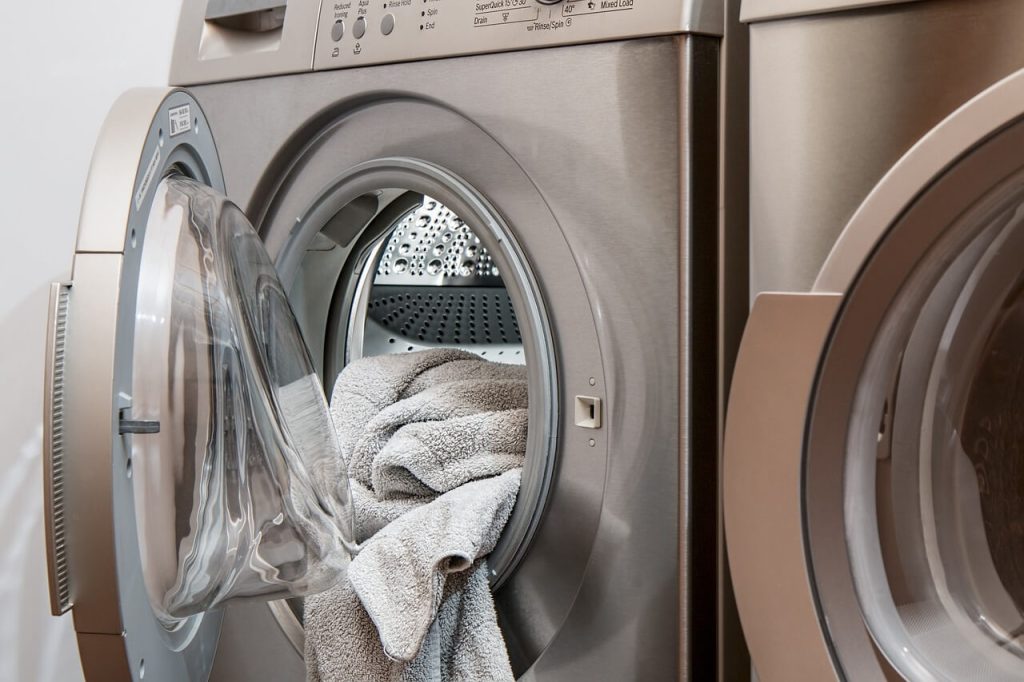
Moving Your Washing Machine? (here’s what you need to know)
If you’re moving house without using a removal company it’s quite a job. One of the biggest challenges you will have is moving bulky items of furniture and household appliances.
This means you’ll need to get some help with these bulky items as you could cause damage to the items or personal injury if you attempt to do this by yourself.
If you’re moving home and you have a washing machine that’s coming with you, keep reading. In this article I will reveal the best and safest way to move and transport a washing machine from one house to another.
Moving A Washing Machine: A Step By Step Guide

Washing machines are heavy, expensive items and one false move could lead to damage to the machine or personal injury. Which is why you should follow this guide to the letter.
Each individual step is necessary for the safe transportation of your washer.
You Will Need:
- A Towel
- A Bucket
- Transit Bolts (front loaders only)
- Pliers
- Moving Blankets
- Rope Or Strapping
- A Dolly (trolley)
- Strong Tape
Method:
- Clean The Appliance
24 hours before the move you should run a hot 90o C service wash on your washer. You can use a commercial washing machine cleaner or 2 cups of white vinegar. - Disconnect The Appliance
On the day of the move, you need to unplug the washer and turn off the water supply by turning the inlet tap to the off position (typically turning the inlet tap in a clockwise direction). - Remove The Inlet Hose & Drain Hose
Using the pliers, detach the inlet hose from the back of the machine and from the inlet tap. Then remove the drain hose from the standpipe (it just lifts out) or unscrew it from the waste pipe under the sink. You might find it useful to place a towel on the floor to soak up any spillage and place the drain hose into a bucket to catch any water. - Secure The Washer For Moving
Tape the drain hose to the body of the washer as well as the power cord. If you are moving a front loading washing machine you will need to replace the transit bolts to prevent the internal components from bouncing around and getting damaged on the move. If you’re moving a top loader, all you need to do is wedge some cardboard between the drum and the casing. - Wrap The Washer
Wrap moving blankets all around the washer to protect it from any scratches or dents. - Move The Washer Onto A Dolly
Once the washing machine is securely wrapped, it needs to be placed on the dolly. Tilt the appliance back slightly and position the dolly under the appliance. Then secure it to the dolly using rope or straps. - Load The Washer Onto The Removal Vehicle
You can now move the washer on the dolly to the back of the vehicle you are using to transport it to your new home. Once you reach the vehicle, get a friend to help you carefully lift the washer from the dolly and onto the vehicle. - Ensure The Washing Machine Is Upright
Washing machines need to be transported in an upright position to avoid damaging any internal components. This means you’ll need a lorry or van or a vehicle with enough clearance for the washer to sit upright. - Secure The Appliance
Once onboard the vehicle, move the appliance to as close to the front of the vehicle as possible and secure it in position using rope or strapping. This will prevent it from moving around whilst in transit.
Tips For The Best Ways Of Moving A Washing Machine

If you’re moving the washer on your own without the help of a professional removal company, it can be challenging. By following the above steps carefully, you shouldn’t have any problems at all.
Below are some useful tips to ensure the move goes smoothly;
Consult Your User Manual
Before you start to move your washer, you should consult your user manual for any model specific instructions. Many manufacturers include certain specific moving instructions which could void any warranty if ignored.
If you can’t find your user manual, search online or contact the manufacturer directly.
Check Your Route
You should measure the doorways, staircases, hallways etc to ensure you have free access through them. Washing machines are heavy appliances and failing to check the route out of the house can cause difficulties.
In some cases, you may need to take an alternative route out of the building to avoid any awkward stairways etc.
Get Help
Whilst it might be possible to move a washing machine on your own, it will be difficult and you’re likely to injure yourself or cause damage to the machine.
Which is why you should get a friend to help you move the washer. If you are on your own, it’s not a good idea to try moving a washing machine. Wait until someone is available to help you.
Wear Protective Clothing
Washing machines are heavy and can sometimes have sharp edges. I recommend wearing reinforced protective footwear and thick gloves when moving any large appliance but especially a washing machine.
Accidents can and do happen, it’s better to be over protected and not need it than to end up with a broken toe or cut hand.
Keep Hoses Safe
It’s easy to misplace loose items like water hoses etc during the excitement of the move. It’s a good idea to store any loose hoses etc inside the drum of the washer wrapped in a towel or blanket to prevent them from rattling around.
This will make them easy to find when you arrive at the new home and need to reconnect the washer.
Don’t Forget The Transit Bolts
Once you arrive at the new home and you’ve got the washer into its new position, don’t forget to remove the transit bolts. Operating the washing machine with the transit bolts still in place can cause serious damage to the machine and void any warranty.
SEE ALSO: Washing Machine Moving & Shaking? Here’s how to stop it
Frequently Asked Questions
It is possible to move a washing machine on your own if you secure it to a dolly (trolley) using strong rope or straps. However, it is not recommended to try and lift a washing machine single-handed. Washing machines are incredibly heavy and could cause injury to yourself or damage to the appliance if handled incorrectly.
The easiest way to transport a washing machine is on a dolly (trolley). You should never attempt to carry a washing machine for too far as it will be very heavy and could cause injury.
If you move a washing machine without transit bolts fitted, the appliance will get internally damaged. It is vitally important that the transit bolts which were supplied with your washing machine are put back in if you intend to move it.
Also, follow us on Pinterest ...



